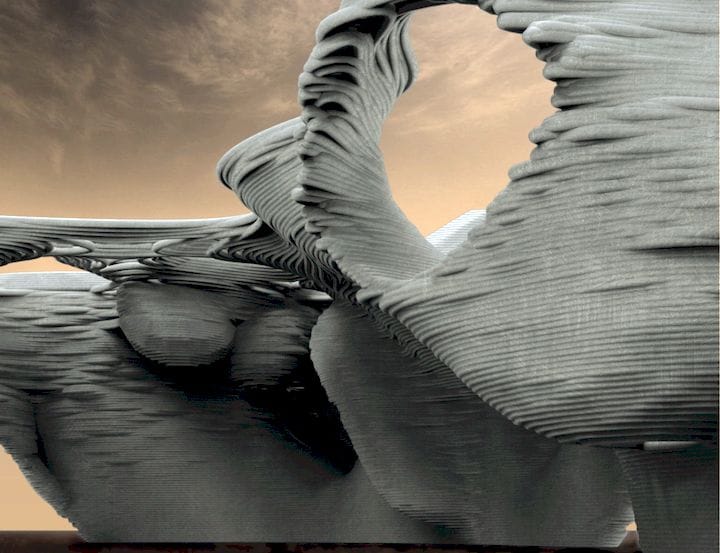![Conceptual outlook of concrete 3D printed structure. [Source: Hosna Shayani, Marie Razzhivina, Jacob Zindroski]](https://fabbaloo.com/wp-content/uploads/2020/05/concrete-reinforcement-design_img_5eb0932f4a92a.jpg)
Researchers have been investigating methods of reinforcing 3D printed concrete.
Jacob Zindroski, Marie Razzhivina and Hosna Shayani, all from Universität Stuttgart, prepared a Masters thesis looking to “expand the design space of 3D printed concrete through tailored reinforcement.” The work is entitled, “ReCrete: Fabrication strategies for precise application of reinforcement in 3D-printed concrete”.
I believe this to be of considerable interest as the current state of affairs in the world of concrete 3D printing is rather primitive. There are a number of notable technology gaps, such as the dearth of design technology that truly leverages 3D printing capabilities, abilities to integrate with traditional building technologies, use of multiple materials or automating non-3D printable component assembly.
But one area is in a bit better shape after this research has taken place: concrete reinforcement. The concrete currently being extruded by the increasingly numerous construction 3D printers is pretty basic.
The problem with concrete is that it is not particularly strong unless it is carefully mixed and reinforced. You can easily see how reinforcement is done in traditional concrete pouring: steel rebar is added to the structure.
How To Reinforce Concrete 3D Prints?
Can this be done during concrete 3D printing? It turns out yes, and there are actually a few companies doing so. However, it seems to be a rather manual and simplistic process at the current time.
![The CyBe Hejimans company places rebar segments inside 3D printed formwork and later infills the printed object. [Source: CyBe ]](https://fabbaloo.com/wp-content/uploads/2020/05/concrete-reinforcement-rods_img_5eb0932f98eaf.jpg)
In some cases, printing pauses while steel rods are manually inserted into the still-wet concrete form. In other cases, rebar is added to the external surfaces of the print. These provide a more or less uniform, but unoptimized, strength factor.
One way to provide a basic form of reinforcement is to simply add fibrous material to the concrete mix. This has been done for hundreds of years in traditional making, but the issue here is to do so without disturbing the flow from the extruder.
![Tailored concrete reinforcement concept [Source: Hosna Shayani, Marie Razzhivina, Jacob Zindroski]](https://fabbaloo.com/wp-content/uploads/2020/05/concrete-reinforcement-tailored_img_5eb0932fdd2b0.jpg)
Reinforcing Concrete 3D Prints
The researchers propose more advanced methods of applying reinforcement. For example, they propose a device that could be attached to a typical concrete extruder that would be able to more intelligently insert reinforcing materials.
What’s interesting about this approach is that the insertions could be controlled via software and thus provide the ability to deploy an optimized strength pattern within the print. This is somewhat similar to generative design, in which material is only printed where it’s actually needed.
![Concept for a reinforced concrete 3D printer [Source: Hosna Shayani, Marie Razzhivina, Jacob Zindroski]](https://fabbaloo.com/wp-content/uploads/2020/05/image-asset_img_5eb093302956c.jpg)
However, the difference here is that the strength elements are embedded within the concrete structure. This is because concrete has a rather poor overhang capability, and there are not a lot of support material options available.
Intelligent Concrete 3D Printing
The idea here is that if the technology is created to provide intelligent reinforcement, then the designs implemented with the concrete 3D printing technologies could be quite a bit different. Today’s designs are beholden to the limitations of the material, but imagine if some of those constraints could be lifted.
There’s far more in this research paper than I can write here, so I strongly recommend you review the entire piece. I should note that it is not laid out like a typical bland research paper containing text and cryptic diagrams only; this paper reads like an annual report from a major company.
Via ResearchGate











COBOD’s BOD2 construction 3D printer seems to be catching on as the company has made multiple sales of the new device.